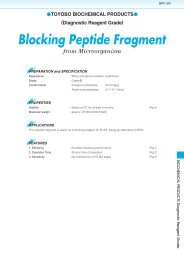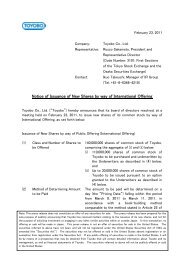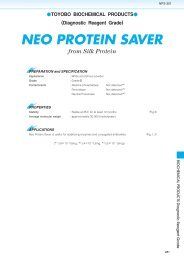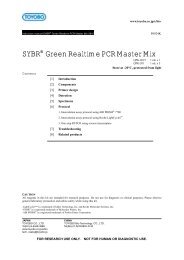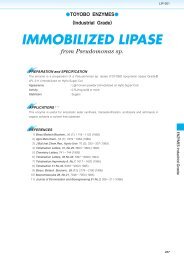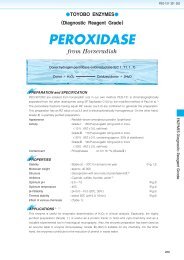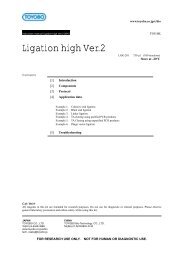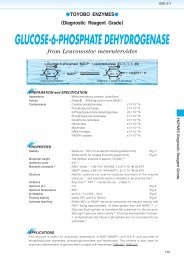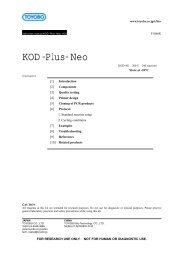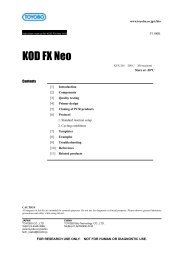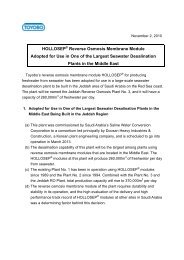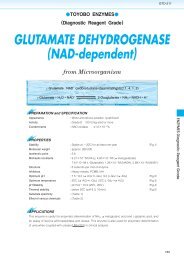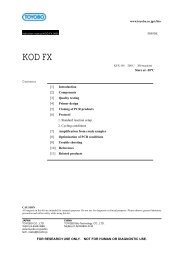D-FRUCTOSE DEHYDROGENASE - Toyobo
D-FRUCTOSE DEHYDROGENASE - Toyobo
D-FRUCTOSE DEHYDROGENASE - Toyobo
You also want an ePaper? Increase the reach of your titles
YUMPU automatically turns print PDFs into web optimized ePapers that Google loves.
FCD-302<br />
TOYOBO ENZYMES<br />
(Diagnostic Reagent Grade)<br />
D-<strong>FRUCTOSE</strong> <strong>DEHYDROGENASE</strong><br />
from Gluconobacter sp.<br />
D-Fructose:(acceptor) 5-oxidoreductase (EC 1.1.99.11) 12)<br />
D-FructoseAcceptor<br />
5-Keto-D-fructoseAcceptor(red)<br />
PREPARATION and SPECIFICATION<br />
Appearance<br />
: Red-yellowish amorphous powder, lyophilized<br />
Activity<br />
: Grade20U/mg-solid or more<br />
(containing approx. 80% of stabilizers)<br />
Stabilizers<br />
: Sugars, amino acids, BSA<br />
PROPERTIES<br />
Stability : Store at 20 Fig.1<br />
Molecular weight<br />
: approx. 140,000 (by gel filtration)<br />
Isoelectric point<br />
: 5.00.1<br />
Michaelis constant<br />
: 510 3 M (D-Fructose)<br />
Inhibitors<br />
: Ag , Hg , SDS<br />
Optimum pH : 4.0 Fig.2<br />
Optimum temperature : 37 Fig.3<br />
pH Stability : pH 4.06.0 (25, 16hr) Fig.4<br />
Thermal stability : below 40 (pH 4.5, 15min) Fig.5<br />
Substrate specificity : (Table 1)<br />
Effect of various chemicals : (Table 2)<br />
APPLICATIONS 3<br />
This enzyme is useful for enzymatic determination of D-fructose in clinical analysis.
FCD-302<br />
ASSAY<br />
Principle:<br />
D-Fructose2Potassium ferricyanide<br />
D-fructose dehydrogenase<br />
5-Keto-D-fructose2Potassium ferrocyanide<br />
2Potassium ferrocyanideFerric sulfate 2Prussian blue3K 2 SO 4<br />
Prussian blue : KFeFe(CN) 6 <br />
The appearance of prussian blue formed by chelate reaction is measured at 660nm by spectrophotometry.<br />
Unit definition:<br />
One unit causes the oxidation of one micromole of D-fructose (the formation of two micromoles of prussian blue) per<br />
minute under the conditions described below.<br />
Method:<br />
Reagents<br />
A. Mclvaine buffer, pH 4.5<br />
B. D-Fructose solution<br />
C. Potassium ferricyanide solution<br />
D. Ferric sulfate-SDS solution<br />
E. Enzyme diluent<br />
Prepare by mixing of 0.1M citric acid and 0.2M disodium phosphate, at<br />
25<br />
1.0M (1.80g D-fructose (MW180.16)/10ml Mclvaine buffer (A) contg.<br />
0.1% Triton X-100)<br />
0.1M (0.33g potassium ferricyanide (MW329.25)/10ml Mclvaine buffer<br />
(A) contg. 0.1% Triton X-100)<br />
5.0g Fe 2 (SO 4 ) 3 H 2 O, 3.0g SDS (sodium dodecyl sulfate), 95ml 85%<br />
phosphoric acid/1,000ml of H 2 O<br />
Mclvaine buffer (A) contg. 0.1% Triton X-100 and 0.05% BSA<br />
Procedure<br />
1. Pipette 0.7ml of Reagent E, 0.1ml of Reagent B and 0.1ml of the<br />
enzyme solution into a test tube and equilibrate at 37 for<br />
about 5 minutes.<br />
2. Add 0.1ml of Raegent C and mix.<br />
3. After exactly 5 minutes at 37, add 0.5ml of Reagent D to stop<br />
the reaction, and then incubate at 37 for further 20 minutes.<br />
Concentration in assay mixture<br />
Mclvaine buffer<br />
Triton X-100<br />
D-Fructose<br />
Potassium ferricyanide<br />
1<br />
0.1%<br />
0.1M<br />
10mM<br />
4. Add 3.5ml of distilled water and measure the optical density at 660nm against water (OD test).<br />
At the same time, prepare the blank by using the same method as the test except that Reagent E (0.1ml)<br />
is used instead of the Reagent B (OD blank).<br />
<br />
Dissolve the enzyme preparation in ice-cold enzyme diluent and dilute to 1.03.0U/ml with the same buffer,<br />
immediately before assay.<br />
Calculation<br />
Activity can be calculated by using the following formula<br />
OD (OD testOD blank)Vtdf<br />
Volume activity (U/ml) <br />
OD2.5df<br />
2.02t1.0Vs<br />
Weight activity (U/mg)(U/ml)1/C<br />
Vt Total volume (5.0ml)<br />
Vs Sample volume (0.1ml)<br />
2.0 Millimolar extinction coefficient of prussian blue under the assay conditions (F/micromole)<br />
2 Factor based on the fact that oxidation of one mole of D-fructose produces two moles of prussian<br />
blue<br />
t Reaction time (5 minutes)<br />
1.0 Light path length (cm)<br />
df Dilution factor<br />
C Enzyme concentration in dissolution (c mg/ml)<br />
REFERENCES<br />
1) M.Ameyama, E.Shinagawa, K.Matsushita and O.Adachi; J.Bacteriol., 145, 814 (1981).<br />
2) M.Ameyama; Methods in Enzymology, vol.89, p.20 (1982).<br />
3) K.Nakashima, H.Takei, O.Adachi, E.Shinagawa and M.Ameyama; Clinica Chimica Acta, 151, 307 (1985).
FCD-302<br />
Table 1. Substrate Specificity of D-Fructose dehydrogenase<br />
Substrate<br />
Concn.(mM)<br />
Relative<br />
activity<br />
D-Fructose 100 100<br />
D-Galactose 100 0.1<br />
D-Glucose 100 0.1<br />
D-Mannose 100 0.4<br />
L-Sorbose 100 0<br />
D-Arabinose 100 0.3<br />
D-Xylose 100 0.2<br />
D-Ribose 100 0.2<br />
D-Rhamnose 100 0<br />
Sucrose 100 0<br />
Lactose 20 0<br />
Maltose 100 0<br />
Raffinose 10 0<br />
D-Sorbitol 100 0<br />
Substrate<br />
Concn.(mM)<br />
Relative<br />
activity<br />
D-Mannitol 100 0<br />
D-Xylitol 100 0<br />
Glucose-1-phosphate 20 0<br />
Fructose-6-phosphate 12.5 0<br />
Fructose-1.6-diphosphate 12.5 0<br />
Glycerol 100 0<br />
D-Glyceraldehyde 20 0<br />
D-Dihydroxyacetone 100 0.1<br />
Ethanol 100 0<br />
Malic acid 100 0<br />
3-Hydroxy-n-butyric acid 100 0<br />
Choline chloride 100 0.1<br />
Potassium gluconate 100 19<br />
Table 2. Effect of Various Chemicals on D-Fructose dehydrogenase<br />
[The enzyme dissolved in Mclvaine buffer, pH 4.5(3U/ml) was incubated with each chemical at 25 for 1hr.]<br />
Chemical Concn.(mM)<br />
Residual<br />
activity<br />
None 100%<br />
Metal salt 2.0<br />
MgCl 2 96<br />
CaCl 2 98<br />
Ba(OAc) 2 98<br />
FeCl 3 88<br />
CoCl 2 95<br />
MnCl 2 80<br />
ZnSO 4 91<br />
Cb(OAc) 2 82<br />
NiCl 2 93<br />
CuSo 4 92<br />
Pb(OAc) 2 82<br />
AgNO 3 0.20<br />
HgCl 2 0.07<br />
Chemical<br />
Concn.(mM)<br />
Residual<br />
activity<br />
NaF 2.0 96<br />
NaN 3 2.0 88<br />
EDTA 4.0 81<br />
o-Phenanthroline 2.0 88<br />
,´-Dipyridyl 1.5 83<br />
Borate 40 89<br />
IAA 2.0 95<br />
NEM 2.0 92<br />
Hydroxylamine 2.0 88<br />
PCMB 1.5 87<br />
MIA 2.0 91<br />
Triton X-100 0.10% 89<br />
Brij 35 0.10% 98<br />
Na-cholate 0.10% 101<br />
SDS 0.05%<br />
6.5<br />
DAC 0.05% 69<br />
Ac, CH 3 CO; PCMB, p-Chloromercuribenzoate; MIA, Monoiodoacetate; EDTA, Ethylenediaminetetraacetate;<br />
IAA, Iodoacetamide; NEM, N-Ethylmaleimide; SDS, Sodium dodecyl sulfate; DAC, Dimethyl-benzyl-alkyl-ammonium<br />
chloride.<br />
100<br />
100<br />
100<br />
Residual Activity,%<br />
50<br />
-20<br />
Relative Activity<br />
50<br />
Residual Activity, %<br />
50<br />
0<br />
0 5 10 15<br />
Period (months)<br />
Fig.1. Stability (Powder form)<br />
kept under dry conditions<br />
0<br />
3 4 5 6 7<br />
pH<br />
Fig.2. pH-Activity<br />
37,5min-reaction in McIvaine<br />
buffer solution<br />
100<br />
0<br />
4 5 6 7 8<br />
pH<br />
Fig.4. pH-Stability<br />
25,16hr-treatment with McIvaine<br />
buffer solution<br />
100<br />
Relative Activity<br />
50<br />
Residual Activity, %<br />
50<br />
0<br />
10 20 30 40 50<br />
Temperature, <br />
Fig.3. Temperature activity<br />
in McIvaine buffer,pH4.5<br />
0<br />
20 30 40 50 60<br />
Temperature, <br />
Fig.5. Thermal stability<br />
15min-treatment with McIvaine buffer<br />
pH4.5. enzyme concn. :3U/ml
FCD-302<br />
<br />
<br />
<br />
D-fructose dehydrogenase<br />
<br />
<br />
<br />
2 4<br />
6 <br />
<br />
<br />
<br />
<br />
<br />
<br />
<br />
<br />
<br />
<br />
<br />
<br />
P<br />
<br />
<br />
P<br />
2 <br />
P<br />
P<br />
<br />
<br />
<br />
<br />
P<br />
<br />
P PP<br />
<br />
P<br />
P<br />
<br />
P<br />
<br />
P<br />
<br />
<br />
P<br />
P<br />
P <br />
<br />
P <br />
<br />
F<br />
<br />
<br />
<br />
P



